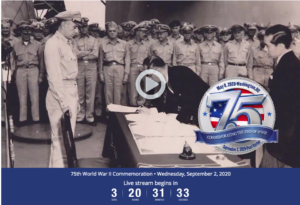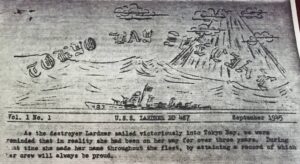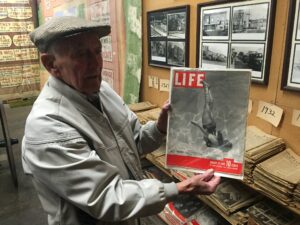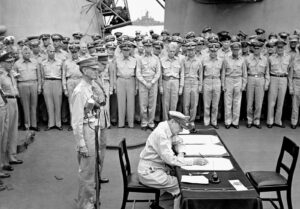Final Surrender’s 75th Anniversary
Use controls above or click here to open this Hometown Heroes podcast in a new window
Episode #643 of Hometown Heroes, airing August 27-31, 2020, prepares you for the 75th anniversary of the signing of the instruments of surrender on the battleship USS Missouri, and the official commemoration on September 2, 2020 in Pearl Harbor with the theme, “Salute their service. Honor their hope.”
Visit the official website of the 75th Commemoration of the End of WWII for more details on the ceremonies this week, including the live stream (also accessible on the organization’s facebook feed) of the ceremony aboard the “Mighty Mo,” beginning at 8:15 am Hawaii Standard Time on Wednesday, September 2nd. This episode includes speeches from President Harry Truman, General Douglas MacArthur, and Admiral Chester Nimitz, all of which were shared with radio audiences around the world on September 2, 1945. Before those addresses, you’ll hear snapshots from three World War II veterans about their experiences on that historic day. Mike Wanty was aboard the destroyer USS Lardner (DD-487), which escorted Admiral Nimitz’s flagship, the USS South Dakota (BB-57) into Tokyo Bay on August 29, 1945.
“We were given the honor of being the first ones in Tokyo Harbor,” Wanty recalled. “Which I didn’t think was the best honor. Our captain was smart enough, we went to general quarters and we had those guns pointed and loaded.”
The Lardner was flanked by two Japanese destroyers, and tensions were high as no one really knew whether the long awaited surrender would actually go off without a hitch. For two days straight, the Lardner circled the harbor, keeping a lookout for potential kamikaze or kaiten (suicide submarine) attacks. Wanty, who passed in 2018 at the age of 97, watched through binoculars on the deck of his destroyer as Allied and Japanese dignitaries completed the surrender ceremony on the USS Missouri. You can access Mike Wanty’s original interview on episode #452 of Hometown Heroes here.
Lee Kizer was aboard the destroyer USS Wilson (DD-408). Four months earlier, he had survived a kamikaze attack that killed five of his shipmates and left an unexploded bomb in one of the ship’s living compartments. On September 2, 1945, the Wilson was acting under very clear and sobering orders.
“During the ceremony for the surrender, in case any rogue Japanese pilot that didn’t want to surrender,” you’ll hear Kizer recall. “Shoot him down immediately.”
The concern was real and palpable, but thankfully, they never faced the need to act on those instructions. You can access Kizer’s complete original interview on episode #508 of Hometown Heroes here, and if you ever pass through Julesburg in northeastern Colorado, make sure to visit him at his Old Ford Garage & Museum.
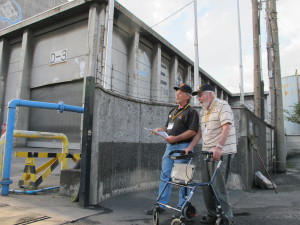
Jack Schwartz (with his son Jack, Jr.) during a 2014 visit to one of the Japanese prison camps where he was held.
The crowd on the USS Missouri on September 2, 1945 included some newly liberated prisoners of war, like Bill Sanchez, who recently celebrated his 102nd birthday in southern California. But some American prisoners still had not experienced liberation day yet, even as that surrender was made official. Jack Schwartz had been captured on Guam on just the second day that America had been at war. He had been taken from prison camp to prison camp, transferred from Kawasaki to Rokuroshi, a mountain camp, in June 1945. By mid-August, after atomic bombs had decimated Hiroshima and Nagasaki and hastened Imprerial Japan’s surrender, guards came to inform the prisoners that “hostilities had ceased.” When the guards vacated the camp, the isolated prisoners knew there was nowhere for them to go, especially in their starved and weakened states.
“We painted a big P-O-W on the roof of the barracks,” Schwartz explained, also relating the results that followed two weeks later. “We saw a B-29 flying way, way above us, and two hours later, parachutes were dropping on the camp, full of food.”
Eventually nurses arrived to care for the prisoners, who were sprayed with DDT to kill lice, bedbugs, and fleas. It wasn’t until September 8, 1945 that they were taken out of Rokuroshi to the battleship USS Iowa in Yokohama, where Jack and other prisoners finally tasted freedom again. Jack Schwartz passed away in 2018 at the age of 2018. You can access his WWII memories in episode #551 of Hometown Heroes here.
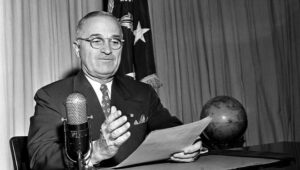
Harry Truman delivering his radio address late at night on September 1, 1945 (September 2 in Japan) – Associated Press Photo
This episode of Hometown Heroes transitions from those veterans’ memories to what was heard on the radio 75 years ago, starting with the words our 33rd president, Harry Truman, shared with Americans from the White House.
“It was a long road to Tokyo, and a bloody one,” you’ll hear in Truman’s voice, informing the people of the surrender. “The evil done by the Japanese warlords can never be repaired or forgotten, but their power to destroy and kill has been taken from them.”
When General Douglas MacArthur took to the microphone after all of the signings were complete, the Supreme Commander of the Allied Powers shared these memorable words:
“Today the guns are silent. A great tragedy has ended. A great victory has been won,” MacArthur began. “The skies no longer rain death. The seas bear only commerce. Men everywhere walk upright in the sunlight. The entire world lies quietly at peace. The holy mission has been completed.”
You can read the entire text of MacArthur’s address on the official website of the Battleship Missouri Memorial here, and you’ll hear every word on Hometown Heroes.
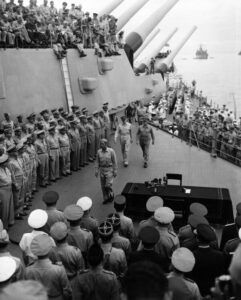
Admiral Chester Nimitz walking next to General Douglas MacArthur on the crowded deck of the USS Missouri.
After MacArthur’s speech, you’ll hear the words of Fleet Admiral Chester Nimitz, who was serving as Commander in Chief of the Pacific Fleet. After saluting the members of the Army, Navy, Marine Corps, Coast Guard, and Merchant Marine as writing “heroic new chapters” in American military history, Nimitz turned his attention to those who gave their lives in the struggle. The Admiral reflected on a military ceremony he had visited on Guam, even reading off some of the names the white crosses bore.
“To them we have a solemn obligation,” Nimitz remarked. “To ensure that their sacrifice will help make this a better and safer world in which to live.”
After a brief update from Navy veteran Bob Mettauer, who was on the USS Ticonderoga (CV-14) on September 2, 1945, and recently reached the milestone of 100,000 miles on his bicycle in Santa Maria, CA, our attention turns to Hawaii, where Tony Vericella leads a committee that has spent the last two years working on plans to commemorate the signing of the surrender aboard the USS Missouri. A lead sponsorship from the Bob & Dolores Hope Legacy Foundation enabled the committee to make plans for dozens of veterans to travel to Hawaii for a special ceremony on the battleship Missouri. Unfortunately, rising COVID-19 numbers in Hawaii led to those plans being reshuffled. World War II veterans living in Hawaii will take place in the ceremony on September 2, which will feature a keynote address from Secretary of Defense Mark Esper. Some of the other veterans who hoped to travel from the mainland to Pearl Harbor will still join the commemoration through technology. 14 World War II-era aircraft were transported to Hawaii aboard the aircraft carrier USS Essex, and those warbirds will take part “Legacy of Peace” aerial parades on August 29, August 30, and September 2. On the 75th anniversary on September 2, the air show and a Navy “pass and review” will precede the formal ceremony that begins at 9:02 a.m. Hawaii Time.
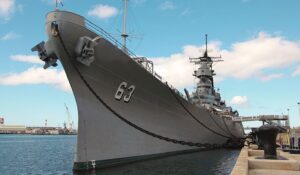
The Battleship Missouri Memorial in Pearl Harbor, where the 75th Commemoration will take place.
“The physical audience will be quite small,” Vericella says of those allowed on the USS Missouri. “But the global audience will hopefully be quite enormous.”
Music from the Pacific Fleet Band and the Royal Hawaiian Band will complement speakers who also include Hawaii governor David Ige and Admiral Philip Davidson, who leads the U.S. Indo-Pacific Command. Tony Vericella believes that while the ceremony is focused on recognizing an important moment in the past, the lessons it can help us remember can inform our present and future.
“The sacrifices that people made on the battlefield, and how they served on the home front are just extraordinary,” you’ll hear him say of the efforts that ended that global conflict 75 years ago. “You can’t help but be inspired and humbled at the same time.”

